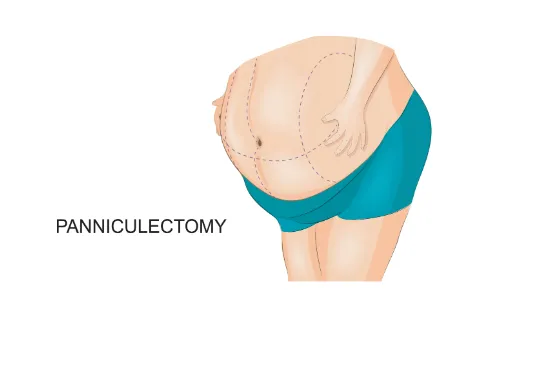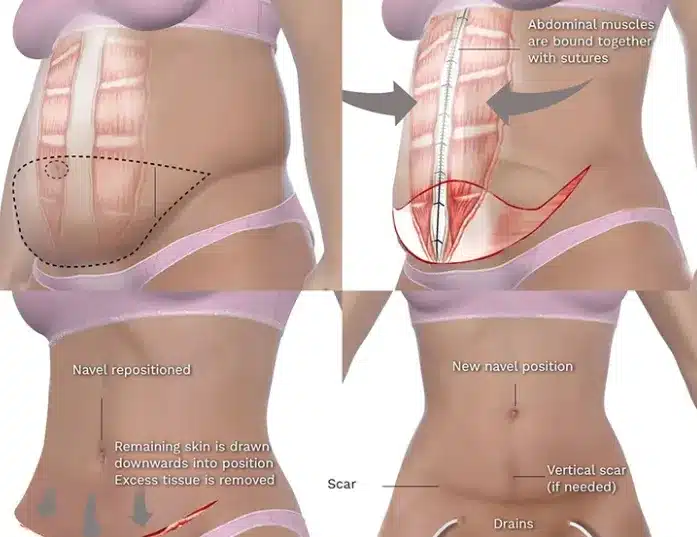Panniculectomy and abdominoplasty are two prominent surgical procedures within the realm of body contouring, specifically addressing issues of excess skin and fat in the abdominal region. While both procedures aim to sculpt and reshape the abdomen, they serve distinct purposes: panniculectomy primarily focuses on removing the pannus or apron of excess skin, often following significant weight loss, while abdominoplasty encompasses additional steps such as muscle repair and skin tightening for a more comprehensive contouring effect. Understanding the differences and benefits of these procedures is essential for individuals seeking to achieve their desired aesthetic goals.
Abdominoplasty Surgery
Regarding cosmetic surgeries that focus on the abdominal region, two standard procedures are abdominoplasty and panniculectomy. While both surgeries aim to enhance the appearance of the abdomen, there are several key differences between the two. In this article, we will explore the definitions of abdominoplasty and panniculectomy and highlight 15 distinctions between the two procedures.
Abdominoplasty, commonly known as a tummy tuck, is a transformative cosmetic surgery aimed at enhancing abdominal contouring. This procedure targets excess skin and fat, tightening abdominal muscles to achieve a flatter, more toned appearance. With its focus on aesthetic refinement, abdominoplasty remains a popular choice for those seeking to sculpt their midsection.
Abdominoplasty, commonly known as a tummy tuck, is a surgical procedure that aims to improve the appearance of the abdomen by removing excess skin and fat while tightening the abdominal muscles. It is typically performed for individuals who have loose or sagging abdominal skin due to factors such as pregnancy, significant weight loss, or aging. Abdominoplasty can help achieve a flatter and more toned abdominal contour.
Clinic contact number: +989371200167
Panniculectomy Surgery
Panniculectomy is a surgical procedure primarily focused on removing excess skin and fat from the lower abdomen, specifically the pannus. The pannus refers to the apron of loose skin and fat that hangs down from the lower abdomen, often as a result of significant weight loss or obesity. Unlike abdominoplasty, panniculectomy does not involve tightening the underlying abdominal muscles. This surgery is usually performed to alleviate physical discomfort or hygiene issues caused by excessive pannus.
Clinic contact number: +989371200167
Differences between Panniculectomy and Abdominoplasty
- Muscle tightening: One of the key differences between Panniculectomy and Abdominoplasty is the difference in muscle tightening. Abdominoplasty involves tightening the abdominal muscles, while Panniculectomy does not focus on muscle tightening.
- Extent of tissue removal: Another major distinction is the extent of tissue removal. Panniculectomy primarily targets the removal of excess skin and fat from the lower abdomen, while Abdominoplasty addresses the entire abdominal region.
- Purpose: The purposes of the two surgeries also differ. Abdominoplasty is primarily performed for cosmetic reasons, aiming to enhance the aesthetic appearance of the abdomen, while Panniculectomy is often performed to address functional issues caused by the pannus.
- Surgical complexity: Abdominoplasty is generally considered a more complex procedure compared to Panniculectomy, requiring additional techniques and considerations.
- Incision length: The length of the incision made during Abdominoplasty is typically longer compared to Panniculectomy, as it involves more extensive tissue manipulation.
- Scarring: Abdominoplasty can result in a longer and more noticeable scar compared to Panniculectomy due to the greater extent of tissue removal.
- Recovery time: The recovery period for Abdominoplasty is usually longer and more involved compared to Panniculectomy due to the more extensive nature of the procedure.
- Insurance coverage: In terms of insurance coverage, Panniculectomy may be covered by insurance if deemed medically necessary, while Abdominoplasty is typically considered a cosmetic procedure and is not covered.
- Combined procedures: Abdominoplasty can be combined with other procedures such as liposuction or breast augmentation, whereas Panniculectomy is usually performed as a standalone procedure.
- Body contouring: Abdominoplasty aims to create a more aesthetically pleasing abdominal contour by addressing muscle laxity and excess skin and fat, while Panniculectomy primarily targets the removal of excess tissue without focusing on body contouring.
- Eligibility: Panniculectomy is generally recommended for individuals with a significant pannus, while Abdominoplasty is suitable for those with excess skin and muscle laxity.
- Results: Abdominoplasty can provide more dramatic and comprehensive results compared to Panniculectomy, including a flatter and more defined waistline.
- Weight loss: While both procedures may result in a slight reduction in weight, Panniculectomy may yield a greater weight loss due to the removal of a larger amount of tissue.
- Cost: Due to its complexity and additional components involved, Abdominoplasty tends to be more expensive than Panniculectomy.
- Patient candidacy: Panniculectomy may be recommended for individuals who are not suitable candidates for Abdominoplasty due to medical or health-related factors.
Differentiating between panniculectomy and abdominoplasty is essential for a successful recovery process.
Recovery from Panniculectomy and Abdominoplasty
The recovery process following panniculectomy and abdominoplasty is generally similar, although abdominoplasty may involve a slightly longer and more involved recovery due to the additional muscle tightening.
- Hospital stay: Depending on the extent of the surgery and the surgeon’s recommendation, you may need to stay in the hospital for a day or two following the procedure.
- Pain management: Pain and discomfort are common after both procedures. Your surgeon will prescribe pain medication to help manage the pain during the initial recovery period.
- Compression garments: Wearing a compression garment or abdominal binder is essential after both procedures. These garments provide support to the surgical site, reduce swelling, and help with the healing process. You may need to wear them continuously for a few weeks or as advised by your surgeon.
- Rest and limited activities: It is crucial to take ample rest during the initial recovery period. Avoid strenuous activities, lifting heavy objects, and bending over for several weeks to allow your body to heal properly. Gradually increase your activity level as recommended by your surgeon.
- Drainage tubes: After surgery, you may have small tubes placed under your skin to drain excess fluid and prevent the accumulation of blood or serous fluid. Your surgeon will provide instructions on how to care for these drains, including emptying and maintaining them until they are removed.
- Follow-up appointments: Regular follow-up appointments with your surgeon are essential to monitor your progress, remove any sutures or drains, and address any concerns or complications that may arise.
It’s important to note that recovery experiences can vary from person to person, and it is crucial to follow your surgeon’s specific instructions for a smooth recovery. They will provide personalized advice based on your individual situation.
The size of a panniculus varies and can be graded on a scale of 1 to 5, which correlates with how far it extends. Grade 1 reaches the mons pubis, while grade 5 extends to or reaches past the knees.NIH
By following these aftercare guidelines specific to panniculectomy or abdominoplasty, you can promote a smooth recovery and achieve optimal results from your surgery. here are separate aftercare guidelines for both panniculectomy and abdominoplasty:
aftercare Panniculectomy and Abdominoplasty
After undergoing panniculectomy or abdominoplasty, proper aftercare is crucial for optimal healing and minimizing complications. Here are some general guidelines for postoperative care:
Aftercare for Panniculectomy
After panniculectomy, diligent monitoring of incisions, adherence to pain management, compression garment usage, activity restriction, hygiene maintenance, and attending follow-up appointments are essential for optimal recovery.
Monitor Surgical Incisions
Keep a close eye on your incisions for any signs of infection, such as redness, swelling, or drainage. Clean the incisions as instructed by your surgeon and keep them dry.
Wear Compression Garments
Your surgeon may recommend wearing compression garments to minimize swelling and support the surgical area. Follow your surgeon’s instructions regarding the duration and type of compression garments to wear.
Manage Pain
Take prescribed pain medications as directed to alleviate discomfort and improve your comfort level. Follow your surgeon’s recommendations for pain management.
Limit Activities
Avoid strenuous activities, heavy lifting, or vigorous exercise for several weeks following surgery. Gradually resume normal activities as advised by your surgeon.
Maintain Proper Hygiene
Keep the surgical area clean and dry to prevent infection. Follow your surgeon’s guidelines for bathing and showering after surgery.
Attend Follow-up Appointments
Attend all scheduled follow-up appointments with your surgeon to monitor your progress and address any concerns or complications promptly.
Aftercare for Abdominoplasty
Proper aftercare for abdominoplasty involves monitoring incisions, managing pain, wearing compression garments, limiting activities, maintaining hygiene, and attending follow-up appointments for optimal recovery.
Similar Incision Care
Follow the same guidelines for monitoring surgical incisions, keeping them clean, and wearing compression garments as directed by your surgeon.
Manage Pain
Take prescribed pain medications as instructed to alleviate discomfort. Your surgeon may also recommend using ice packs or other methods to manage pain and swelling.
Limit Activities
Avoid strenuous activities, heavy lifting, or bending at the waist for several weeks following surgery. Gradually resume normal activities as advised by your surgeon.
Healthy Diet
Maintain a balanced diet rich in vitamins, minerals, and protein to support the healing process. Stay hydrated by drinking plenty of water.
Attend Follow-up Appointments
Regularly attend follow-up appointments with your surgeon to assess your progress and address any concerns or complications promptly.
By following these aftercare guidelines specific to panniculectomy or abdominoplasty, you can promote a smooth recovery and achieve optimal results from your surgery.
Clinic contact number: +989371200167

Panniculectomy and Abdominoplasty Innovations at Prominent Institutions
In the realm of body contouring surgeries, Panniculectomy and Abdominoplasty stand as pivotal procedures, advancing under the expertise of notable figures such as Dr. Jeffrey M. Kenkel, a renowned plastic surgeon affiliated with the University of Texas Southwestern Medical Center. Dr. Kenkel’s groundbreaking contributions in abdominoplasty techniques have been instrumental in shaping contemporary practices in this field. Moreover, institutions like the Mayo Clinic, recognized for their multidisciplinary approach to patient care, have spearheaded research endeavors exploring the efficacy and safety profiles of panniculectomy and abdominoplasty, elucidating nuanced aspects such as complication rates and patient satisfaction.
Among the forefront institutions in the provision of panniculectomy and abdominoplasty services is the Cleveland Clinic, distinguished for its comprehensive plastic surgery department and cutting-edge surgical innovations. Recent statistical data from the American Society of Plastic Surgeons reveals a steady increase in demand for both procedures, with a notable 10% rise in abdominoplasty surgeries reported in the past year.
Furthermore, advancements in surgical techniques, including the incorporation of minimally invasive approaches and enhanced recovery protocols, have contributed to the improved safety and efficacy of panniculectomy and abdominoplasty, thus reinforcing their pivotal roles in the realm of body contouring surgery.
Summary
In conclusion, both panniculectomy and abdominoplasty offer significant benefits in body contouring, addressing excess skin and fat in the abdominal area to enhance the overall silhouette. However, it’s crucial for patients to recognize the distinctions between the two procedures, with panniculectomy primarily focusing on removing the pannus and abdominoplasty involving additional steps such as muscle repair and skin tightening. Moreover, understanding the recovery period and scar management strategies associated with each procedure is vital for setting realistic expectations and optimizing outcomes.
By adhering to postoperative guidelines, including proper scar care and attending follow-up appointments, patients can contribute to higher levels of patient satisfaction and achieve the desired aesthetic results from panniculectomy or abdominoplasty.

FAQs
1. Which procedure is more suitable for me between Panniculectomy and Abdominoplasty?
The most suitable procedure for you depends on various factors, such as your aesthetic goals, the extent of excess skin and fat, muscle laxity, and overall health.
2. Will these procedures help me lose weight?
While both Panniculectomy and Abdominoplasty can result in a slight reduction in weight due to the removal of excess tissue, they are not intended as weight loss procedures.
3. Will insurance cover Panniculectomy and Abdominoplasty?
In general, abdominoplasty is considered a cosmetic procedure and is not covered by insurance.
4. Will there be visible scarring after panniculectomy or abdominoplasty?
Both procedures result in surgical scars, typically located in areas concealed by underwear or swimwear. The appearance of scars can vary depending on individual healing and surgical techniques used. However, surgeons aim to minimize scarring and provide instructions for scar care to optimize healing.
5. Can abdominoplasty or panniculectomy help with weight loss?
While both procedures can remove excess skin and fat, they are not weight loss surgeries. However, they can enhance body contouring and improve the appearance of the abdomen, which may contribute to a more proportionate figure after significant weight loss.
Panniculectomy – StatPearls – NCBI Bookshelf (nih.gov)




